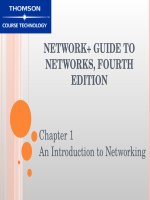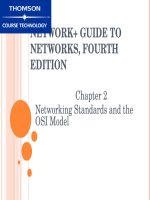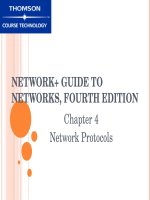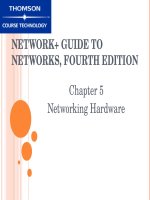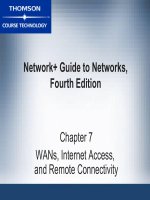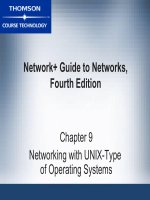Guide to network essentials 4th chapter 07
Bạn đang xem bản rút gọn của tài liệu. Xem và tải ngay bản đầy đủ của tài liệu tại đây (2.26 MB, 60 trang )
Chapter 7:
Network Architectures
Learning Objectives
Understand the different major network
architectures, including 10 Mbps Ethernet,
100 Mbps Ethernet, Gigabit Ethernet, token
ring, AppleTalk, FDDI, and ATM
Understand the standards governing
network architectures
Understand the limitations, advantages, and
disadvantages of each standard or
architecture
Guide to Networking Essentials, Fou
2
Ethernet
Many experiments in early 1960s and 1970s to
connect several computers and share data
ALOHA
network at University of Hawaii
Early version of Ethernet developed at Xerox’s Palo
Alto Research Center in 1972
DIX (Digital, Intel, Xerox) developed standard that
transferred at 10 Mbps
IEEE used it as basis for 802.3 specification
Guide to Networking Essentials, Fou
3
Overview of Ethernet
Popular network architecture with many advantages:
Ease
of installation
Low cost
Support for different media
Features include packing data into frames, using
CSMA/CD channel access, and using hardware
(MAC) address
Divided into three categories based on transmission,
speed, and media
Guide to Networking Essentials, Fou
4
10 Mbps IEEE Standards
Four major implementations:
10Base5
– using thick coaxial cable
10Base2 – using thinnet coaxial cable
10BaseT – using unshielded twisted-pair (UTP) cable
10BaseF – using fiber-optic cable
Of these standards only 10BaseT and 10BaseF are
commonly seen today
Guide to Networking Essentials, Fou
5
10BaseT
Uses Category 3, 4, or 5 unshielded twisted-pair
(UTP) cable
Low cost makes it most popular Ethernet network
Wired as star topology but uses bus signaling
system internally, as shown in Figure 7-1
No more than five cabling segments, no more than
four hubs between communicating workstations
Up to 1024 computers
Guide to Networking Essentials, Fou
6
10BaseT Network Uses Star Topology
Guide to Networking Essentials, Fou
7
10BaseT (continued)
100 meter maximum cable segment length
Table 7-1 summarizes 10BaseT Ethernet
See Simulation 7-1 for a visual study of Ethernet
operation
Guide to Networking Essentials, Fou
8
10BaseT Ethernet Summary
Guide to Networking Essentials, Fou
9
10BaseF
Uses fiber-optic cable
Three subcategories:
10BaseFL – links computers in LAN environment
10BaseFP – links computers using passive hubs;
maximum cable segment length of 500 meters
10BaseFB – uses fiber-optic cable as backbone
between hubs
Usually wired as a star with maximum of 1024 nodes
connected by repeaters
Table 7-2 summarizes 10BaseF Ethernet
Guide to Networking Essentials, Fou
10
10BaseF Ethernet Summary
Guide to Networking Essentials, Fou
11
100 Mbps IEEE Standards
Two most popular 100 Mbps Ethernet standards
are:
100BaseT,
also called Fast Ethernet
100 VG-AnyLAN – Short-lived technology that is
rarely if ever seen in today’s networks
Guide to Networking Essentials, Fou
12
100BaseT
Current IEEE standard is 802.3u
Three substandards define cable type:
100BaseT4
– four-pair Category 3, 4, or 5 UTP
100BaseTX – two-pair Category 5 UTP
100BaseFX – two-strand fiber-optic cable
Guide to Networking Essentials, Fou
13
100BaseT (continued)
Two types of 100BaseT hubs:
Class
I – may have only one between communicating
devices
Class II – may have maximum of two between
devices
Figure 7-2 shows switches interconnecting
multiple hubs
Table 7-3 summarizes 100BaseT Ethernet
Guide to Networking Essentials, Fou
14
Switch Interconnects
100BaseT Hubs
Guide to Networking Essentials, Fou
15
Summary of 100BaseT Ethernet
Guide to Networking Essentials, Fou
16
Gigabit Ethernet:
1 Gbps IEEE 802.3z Standards
1000BaseX identifies various Gigabit Ethernet
standards
Requires
different signaling methods
Uses 8B/10B coding scheme with 8 bits of data and 2
bits of error-correction data
Most use full-duplex mode
Guide to Networking Essentials, Fou
17
Gigabit Ethernet:
1 Gbps IEEE 802.3z Standards (continued)
Two separate extensions cover 1000BaseX and
1000BaseT
802.3z-1998 – covers 1000BaseX including:
L
– long wavelength laser/fiber-optic
S – short wavelength laser/fiber-optic
C – copper jumper cables
802.3ab-1999 – covers 1000BaseT requiring
four pairs of 100-ohm Category 5 cable or better
Guide to Networking Essentials, Fou
18
10 Gigabit Ethernet:
10 Gbps IEEE 802.3ae Standard
Anticipated ratification in late 2002
Runs only on fiber-optic cabling, using both
single-mode and multi-mode
Maximum length is 5 km
Uses full-duplex
Likely to be used as network backbone and in
Storage Area Networks (SANs)
Able to scale from 10 Mbps to 10 Gbps speeds
Guide to Networking Essentials, Fou
19
What’s Next For Ethernet?
40 Gbps implementations are underway
100 Gbps could be possible by 2006
Terabit (1000 Gigabit) may be seen by 2011 and
10 Terabit by 2015
Major implications for these tremendous rates of
speed in the areas of entertainment and
business
Guide to Networking Essentials, Fou
20
Ethernet Frame Types
Four unique Ethernet frame types:
Ethernet 802.3 used by IPX/SPX on Novell NetWare
2.x or 3.x networks
Ethernet 802.2 used by IPX/SPX on Novell 3.12 and
4.x networks; default with Microsoft NWLink
Ethernet SNAP used with EtherTalk and mainframes
Ethernet II used by TCP/IP
Types must match for two devices to communicate
Packet size ranges from 64 to 1518 bytes
Guide to Networking Essentials, Fou
21
Ethernet 802.3
Also called Ethernet raw
Does not completely comply with 802.3
specifications
Used with Novell NetWare 2.x or 3.x
Figure 7-3 shows frame
Guide to Networking Essentials, Fou
22
Ethernet 802.3 Frame
Guide to Networking Essentials, Fou
23
Segmentation
Breaking network down into manageable pieces
Uses switch or router between network
segments
Allows for more efficient network traffic
See Figure 7-5
Guide to Networking Essentials, Fou
24
Switch Segments Network
Guide to Networking Essentials, Fou
25

